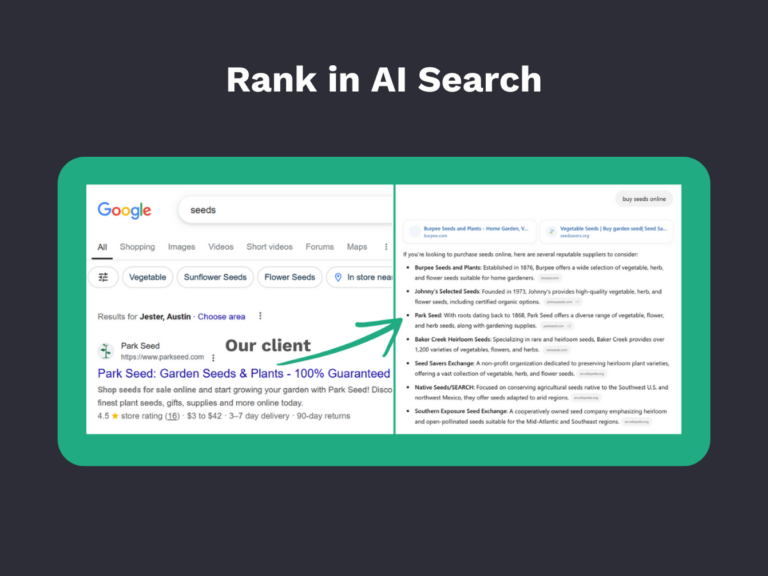Hot take: your company’s blog could be your most powerful marketing tool – even if it hasn’t worked for you before, and even if you’ve never written a post.
But many businesses shy away from blogging, believing it’s too time-consuming or that outsourced content won’t do justice to their brand.
Understandable concerns.
But here’s the thing: when someone’s searching for solutions to their problems, the key factor they care about is whether the information they find actually helps them in a meaningful way.
Think about it: if you were trying to find a solution to your business’s bleeding-neck attrition problem, or trying to troubleshoot why your water heater isn’t working at 5 in the morning, would you think to yourself, “Wow, this article is super helpful, but I wonder if it’s in line with the company’s brand guidelines?”
Your blog content shouldn’t just showcase what your business wants to talk about. Instead, it should focus on answering the questions your audience is asking. This is where our data-driven approach to keyword research, audience insights, and SEO best practices comes into play.
In this article, we’ll explain the methodology Digital Position uses to determine the most valuable blog topics for your business. We’ll cover keyword research, keyword gap analysis, the balance between brand voice and audience interests, and why quality over quantity is the game plan in today’s content landscape.
What Is Keyword Research, and Why Does It Matter?
Keyword research is the process of identifying the specific words and phrases your target audience uses to search for solutions, information, or services related to your business. This research allows us to get into the minds of potential customers and figure out exactly what they are looking for—so that your content meets their needs.
Why Keyword Research Is Critical
- Audience Insight: Keyword research helps us understand the questions, pain points, and interests of your target audience. For example, someone searching for “best HVAC repair in Charlotte” is likely a high-intent customer looking for immediate service. If your business shows up in search results for that keyword, you’re addressing a real need.
- SEO: Search engines like Google rely on keyword relevance to rank content. If your content answers the questions people are actually searching for, your website is more likely to rank higher, leading to more organic traffic.
- Competitive Advantage: Knowing what keywords your competitors rank for allows us to build a strategy that helps your business outperform them, particularly in areas where they may be missing opportunities.
How We Conduct Keyword Research
At Digital Position, we use several tools to conduct in-depth keyword analysis, such as:
- SEMRush: This tool allows us to see the keywords your competitors are ranking for, helping us target high-traffic, high-value terms.
- Google Trends: This tool helps us track the popularity of specific search terms over time, allowing us to stay ahead of shifting search behavior and seasonal trends.
- AlsoAsked and Detailed: These tools help us analyze queries adjacent to the primary topic that users search for, providing insights into searcher intent.
- Ahrefs: We track competitor pages over time to understand the specific edits and content changes that helped improve rankings, informing us on what will most likely work well for your content.
What Is a Keyword Gap Analysis?
A keyword gap analysis identifies the keywords your competitors are ranking for that your website is not. This helps us uncover content opportunities—keywords and topics that can drive traffic to your site but aren’t yet being addressed in your current content strategy.
How We Use Keyword Gap Analysis
- Competitor Benchmarking: We analyze what your competitors are ranking for and which keywords they dominate. This often reveals missed opportunities where your competitors are drawing traffic, but your site is not.
- Content Opportunities: By identifying these gaps, we can recommend topics that fill these holes in your content strategy. These often involve high-impact keywords that haven’t been covered on your site yet.
- Strategic Prioritization: Not every gap should be addressed immediately. We prioritize gaps based on the potential traffic they can drive, how relevant they are to your business, and how likely they are to convert visitors into leads.
Balancing Brand Voice with Audience Interests
One of the most common concerns we hear from clients is about brand voice. Many wonder why our recommended blog topics don’t always reflect their exact brand voice or focus solely on their products and services. The reality is that blog content must answer what your audience cares about—not just what your business wants to talk about.
The Importance of Audience-Centric Content
Your audience is searching for answers to their problems—not necessarily your specific services right away. For example, a blog post titled “How to Winterize Your Home” might not directly promote your HVAC services, but it provides valuable content that your audience is actively searching for. Once they trust your business as an expert source of information, they’re more likely to turn to you for services when they’re ready to make a decision.
Positioning Your Brand for SEO Success
We understand that your brand voice is critical, and our goal is to position it in a way that resonates with both your audience and search engines. Some blog posts are crafted to answer specific questions and drive traffic to your site. These may not always showcase your brand voice prominently, but they help you gain visibility. Other posts, such as thought leadership pieces or updates, are designed to let your brand personality shine and engage readers who are more familiar with your business.
It’s about balancing brand voice and audience needs—allowing your content to be both authoritative in search results and reflective of your business values.
Why Writing for SEO Isn’t Just About Keywords Anymore
A common misconception is that SEO writing is all about including the right keywords in your content. With the rise of AI and frequent changes in Google’s algorithms, SEO has become much more sophisticated.
SEO in the Age of AI
While AI tools can generate content quickly, search engines prioritize quality. Google now looks for content that is:
- Original: Repeating the same content that your competitors are publishing won’t help your rankings.
- High-Quality: Detailed, well-researched content that answers specific questions and solves real problems will outperform generic, surface-level posts.
- Engaging: Content that keeps visitors on your site longer—through a clear, readable structure and helpful information—sends signals to search engines that your site is useful.
That’s why Digital Position encourages a quality-over-quantity approach to blog writing. Instead of publishing numerous short, low-value articles, we focus on creating fewer, high-impact posts that establish your business as a trusted authority in your industry.
Looking at Content as a Collection, Not a Single Post
One point we always stress to our clients is that blog content should be viewed as a bulk effort, not on a per-post basis. Your blog should be thought of as a book with many chapters—some chapters showcase your brand voice, others answer critical audience questions, and some are purely educational.
How Does This Work?
- Not Every Post Needs Your Brand Voice: While it’s useful to maintain your brand’s tone in some articles (such as company updates or thought leadership pieces), it’s equally important to cover topics that your audience is actively searching for — even if they don’t always reflect your core messaging.
- Diverse Content Is Key: Your blog should contain a mix of informational, promotional, and engaging content. Some posts might answer practical questions like “How to Maintain Your HVAC System,” while others can highlight your business’s core values or innovations.
We also create content with different audiences in mind. Some blog posts are meant for top-of-funnel visitors who may be new to your site and simply searching for an answer to a broad question. Others are aimed at people who are further along the customer journey—these posts can include more brand voice and showcase your unique value proposition.
By viewing your blog as a collective body of work, you can create a comprehensive resource that serves different needs and appeals to a wider audience.
Where Do You Go From Here?
If you’re convinced of the value of a data-driven, audience-focused content strategy, consider the strategic implications for your business:
- Resource Allocation
- Assess your current marketing budget. How much can you realistically allocate to content creation and SEO?
- Consider the trade-offs: What other marketing initiatives might need to be scaled back to accommodate this new approach?
- Team Structure
- Evaluate your existing team. Do you have the right skill sets in-house to execute this strategy?
- Decide whether to train existing staff, hire new talent, or partner with a specialized agency.
- Performance Metrics
- Define what success looks like for your content strategy. Is it leads, revenue, market share?
- Align content KPIs with broader business objectives to ensure cohesion.
- Content Governance
- Develop a framework for maintaining quality and consistency across all content.
- Establish clear guidelines on how to balance SEO needs with overall brand strategy.
- Long-term Vision
- How does this strategy fit into your company’s 3-5 year plan?
- Consider how it might evolve as your business grows and markets change.
Want expert guidance on implementing a data-driven content strategy, or need help course-correcting an existing approach that’s not delivering results? Let’s chat – no pressure, no hardsells, just strategic advice to help you with your content and SEO initiatives.





no replies